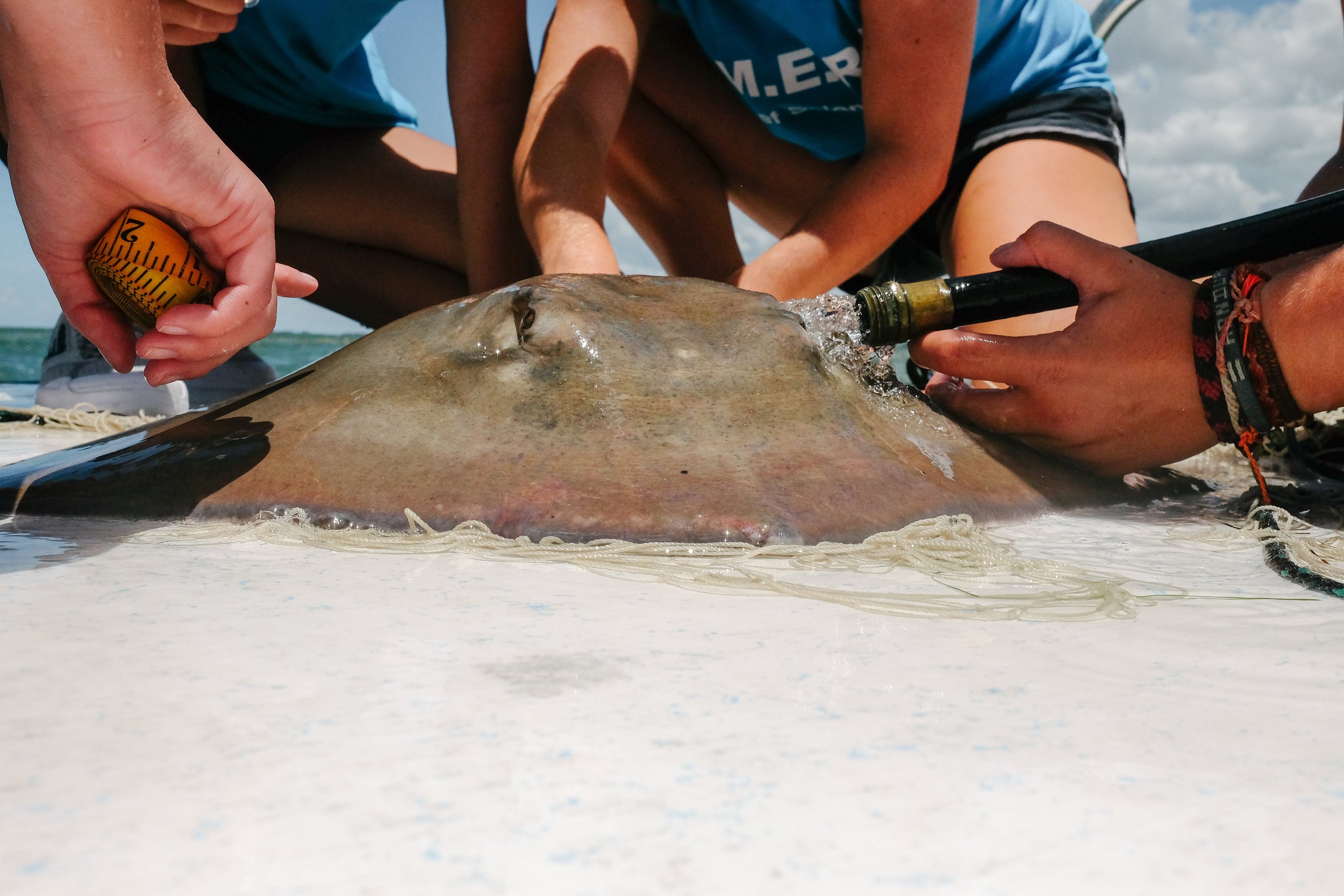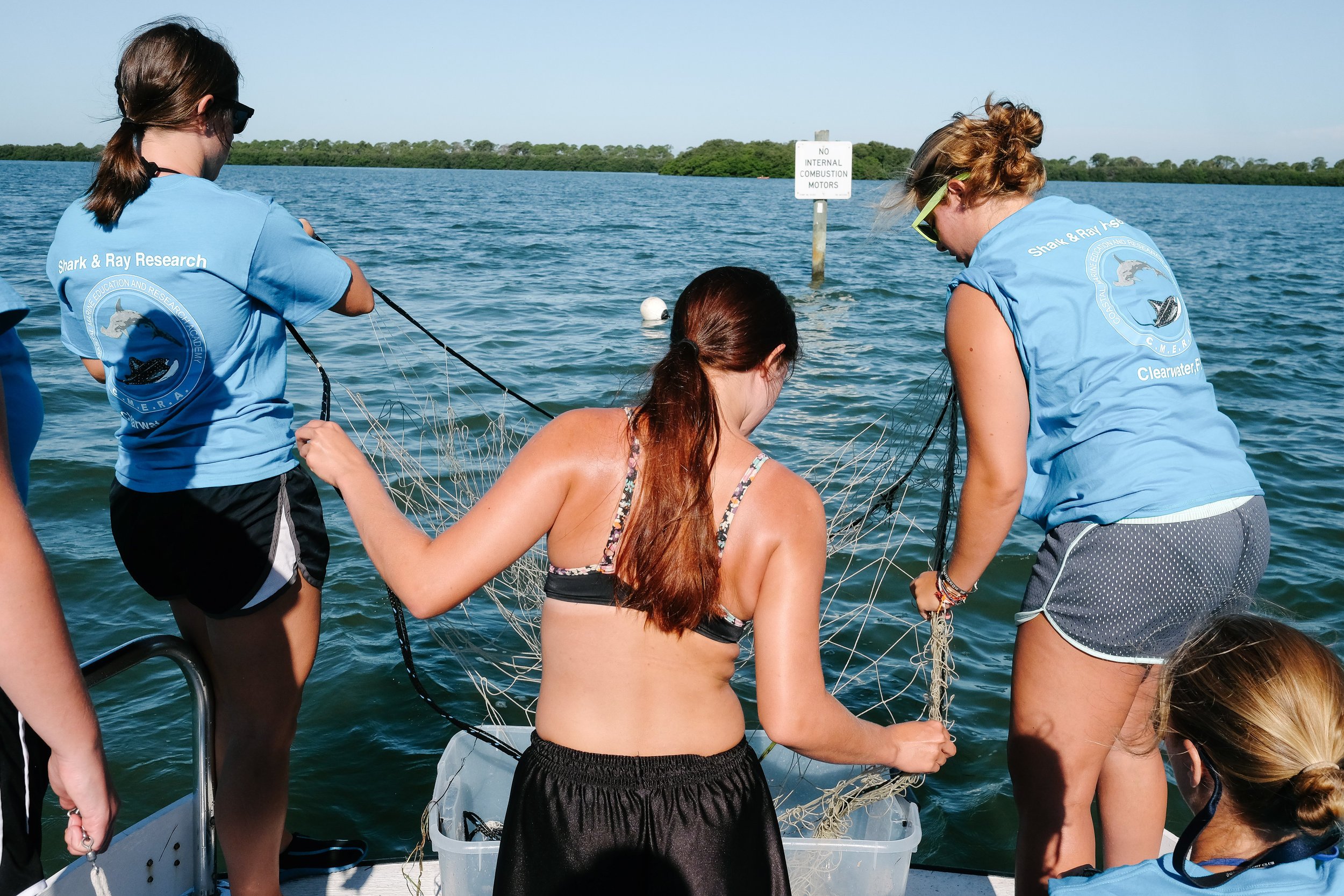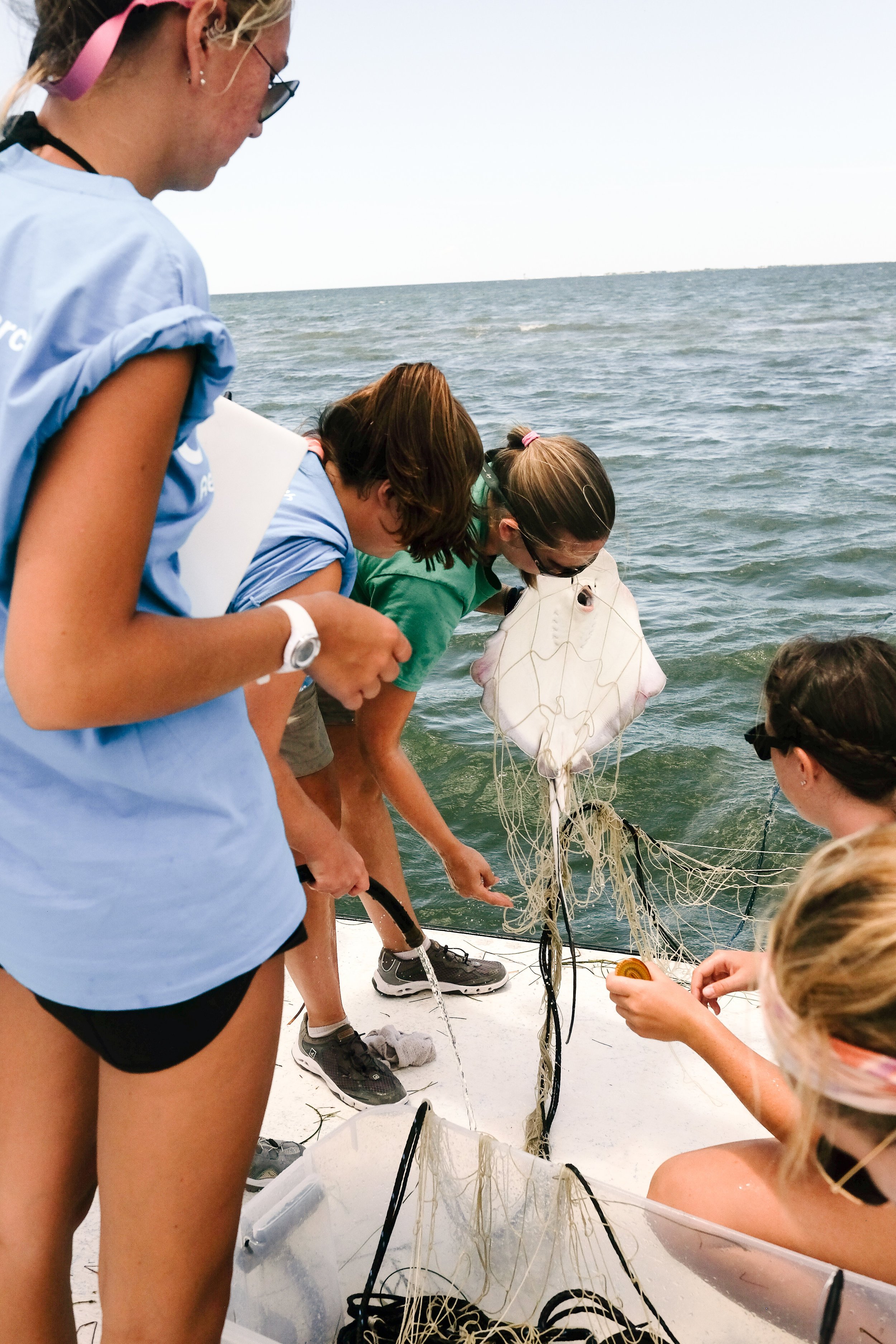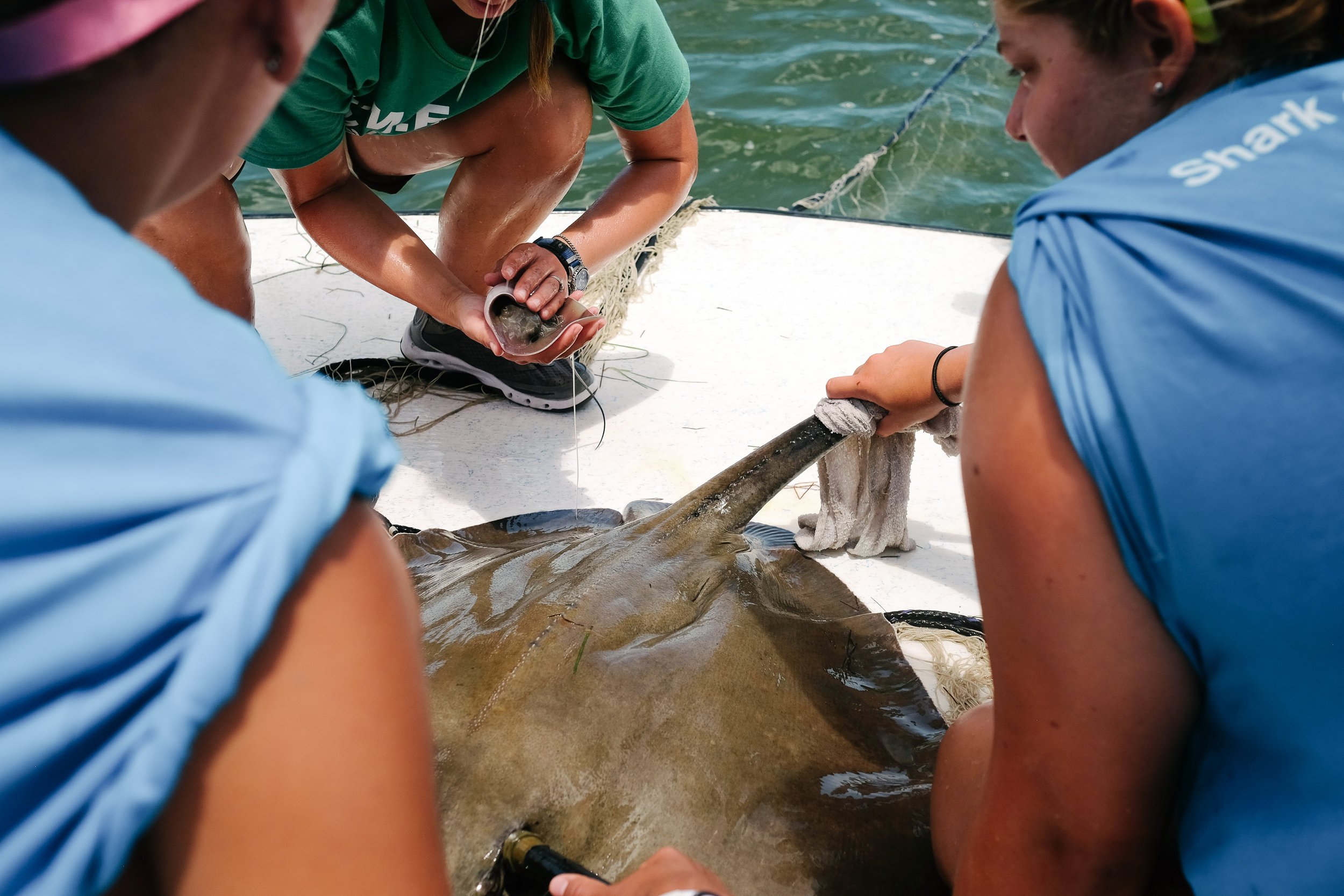Mariah Moore :: Marine Biologist
I grew up with water. Fifteen minutes from the beach. A pool in the back yard. Lakes and fresh water springs never more than a few miles away. But I live in Colorado now, and I miss the water. A lot. So pretty much not a trip to a state with coastline goes by where I don’t take the time to get my fix. This obsession with water is exactly how I find myself here: crouching on the bow of a boat in the Gulf of Mexico looking into the startled eyes of a southern stingray.
The ray is a muddy, olive-brown color, slightly longer than the length of my arm at its widest section. Its body is shaped like a diamond. A diamond, it’s worth noting, with a long tail and serrated barb protruding from one end. But it’s the ray’s hazel eyes that hold me for the moment. I swear that behind this animal’s blank stare, it is silently asking the only question that seems relevant at the moment: How in the world did I get on this boat?
The answer is that a team of marine biology students caught it. And now they’re going to trim that venomous barb along the top of the southern stingray’s tail, attach a small tag to its right pelvic fin, and collect a small DNA sample before releasing it back into the ocean. The whole process will take just a few minutes.
But First, A Lecture
This scene plays out each summer weekday aboard the Coastal Marine Education and Research Academy (CMERA) boats off the coast of Dunedin, Florida. Before catching and releasing marine animals, however, days at CMERA begin in the classroom. When I show up at their headquarters at 8:00 a.m. on a Tuesday in late summer, Moriah Moore opens the front door to greet me. Moriah is CMERA’s president and lead marine biologist. Tan from a summer spent on the water, her sandy blond hair is pulled back into a ponytail and she’s decked out for work in shorts and a green t-shirt. She gives me a quick, matter-of-fact tour of the organization’s simple space located in a nondescript office building near a bustling highway. There are two sparse classrooms, a kitchen, and a small lobby, which is where I’m standing and staring at a display of sand dollars and shark teeth when a stream of people files in.
The six young women, all college students, hail from near and far: Boston, Rhode Island, Florida. But they are all here for one reason: to gain field research experience during CMERA’s summer program.
The program, which runs from May through August, allows participants to conduct research on the various shark and stingray species found along Florida’s Gulf Coast. Some people come for a week. Others stay all summer, logging college credits and increasing their responsibilities as their experience accumulates.
While the students quickly settle at long white tables in the front classroom, Moriah launches into the morning’s lecture. Today she’s covering the spotted eagle ray, showing slides as she discusses the animal’s anatomy, feeding behaviors, and reproduction habits. Her students soak up the knowledge, taking notes and asking questions. Moriah shares current research and conservation concerns with the group as well as personal stories, like the times she’s witnessed spotted eagle rays jumping out of the water, a behavior the species is somewhat known for, yet one scientists still do not completely understand. In what seems like no time, the lecture is over and the gang gathers their belongings, piles into a van, and heads to the marina.
"Let's go fishing," Moriah says.
All Aboard
The eight of us board one of CMERA’s three boats, slathering on sunscreen, stowing our gear in the tiny compartments, and listening to Moriah’s safety overview. Minutes later, we motor out of the marina, our combined excitement palpable.
“We can catch any of six species of rays out here,” Moriah tells me as she maneuvers the boat under a bridge. “And as many as ten species of sharks.” When I ask her what kinds, she rattles off a list of names. Atlantic sharpnose. Blacknose and blacktip. Also “a fair number of bonnetheads and great hammerheads.”
“Here?” I say, motioning to the seemingly quiet waters around us.
“Yep. Even bull sharks and tiger sharks. They’re all here inshore.”
I’m shocked there are so many species of sharks and rays swimming, quite possibly, beneath us at that very moment.
“We probably won’t catch any sharks today,” Moriah adds, perhaps sensing my disbelief. “We’re not longlining, we’re using nets.” Those nets are 200-foot tangle nets, and I’m about to get my first demonstration on how to use them.
Moriah slows the boat near a small barrier island and one of the women tosses our anchor overboard. The readout on the fish locator perched next to the captain’s chair shows a water depth of 6.8 feet and a temperature of 86 degrees, “pretty warm but typical for the middle of summer,” Moriah says.
Then, as Moriah slowly drives in reverse, three of the women carefully unravel the tangle net from a container on the bow of the boat and feed it into the water. Weighted at its bottom, the 6-foot-high net stretches out in the water like a wall. It’s weave is tight enough to catch larger marine animals like rays, but loose enough to allow small fish to easily swim through it. When the net is set in the water, we wait.
30 Minutes Feels Like Eternity
We leave the net in the water for 30 minutes, a length of time which feels like an eternity when you are expecting something. A something that could be anything. As we wait, and I try not to think about how many minutes have passed (just five), we make small talk. I learn the schools the women go to (Rider University, Boston College, the University of South Florida, the University of Maine) and what they are studying (conservation, marine science, ocean ecology). When there’s 10 more minutes to go, I spot a small pod of dolphins swimming by in the distance. I don’t know why, but I take the site as a good omen.
Finally, our 30 minutes is up and the three women who set the net head back to the bow to pull it in. The rest of us gather in an anxious semi-circle several feet behind them. The net comes out of the water slowly. I have my camera ready and feel like I am breathing in slow motion, waiting for a glimpse of something, anything moving in the net. But as the women near the end of the line, our hopes for sea life are dashed.
“Empty,” one of the women shouts back at Moriah.
“Ok,” she responds flatly. “Let’s set it again.”
The women repeat the process of lowering the net in the water. And when it is down, the rest of us repeat the process of sitting idle and waiting. Thirty minutes later, they pull the net up again. And again it is empty. A third time also fails to yield results.
We’ve been on the boat for over two hours and I start to feel like I’m jinxing the trip. Moriah told me earlier that they typically average eight to 10 animals in their nets per day.
"Don't worry," she notes now. "We tend to catch more rays during the outgoing tide."
“Why is that?”
“The animals are moving faster then because they’re about to be flushed out of areas that are too shallow. With incoming tides, animals come in slower, maybe one at a time.”
“What tide is it now?” I ask.
“Incoming,” she says. “But the tide is about to turn.”
Catch of the Day
And turn it does. When we next pull the net out of the water, we have our first catch of the day, actually catches, plural, because there are three stingrays in the net this time.
Upon hearing the pronouncement that we’ve caught something, Moriah moves out from behind the captain’s chair and joins her students at the front of the boat. She deftly removes the ray from the net and slides it onto the bow.
“Water,” she says. And someone immediately grabs a hose and begins pumping seawater into the ray’s spiracles. These two small openings on top of the ray take in the water and pump it out through its gills so the animal can breathe. Next, with a rag in hand, Moriah holds the ray’s tail out of harm’s way while she quizzes her students and asks them to identify the species. We’re looking at a southern ray, I soon learn, easily identifiable with its angular, diamond-shaped body. Next, Moriah flips the animal over to reveal its white underbelly and the students gather around and identify it as a female.
“Ok. Are you ready?” Moriah asks the six students hovering over her. They nod in unison, gathering equipment and nerve. Moriah makes sure someone has a good hold of the slippery ray and then steps back. She supervises as the women first snip off the end of the ray’s serrated barb as a safety precaution. The barb is covered in a venomous mucus and being pricked by it can feel “like a super painful bee sting,” Moriah tells me as we watch the women work as a team. “Being impaled by one, however… that’s much worse.”
“Will it grow back?” I ask.
“Yep. The left-over stump will fall off naturally and in a few weeks’ time another will have regrown in its place.”
I continue to look on as the team measures the ray (this one has a 72 cm disc width) and records the stat in a notebook along with environmental data, including the date, time of day, water, and air temperature. As they call out facts to one another, one student cuts a small triangle out of the ray’s left pelvic fin (the DNA sample) and places it in a plastic vial while another attaches a tracking tag to the right pelvic fin. Moments later the process is complete and a student slides the ray back into the water.
The next two rays pulled out of the net are similar. They are again southern rays, again female. As I look on, the students resume their roles as marine biologists and Moriah resumes her role as supervisor. I notice that she knows precisely how to balance her job as a mentor and instructor while letting the students take the reins.
A Blanket of Rays
Before her days entailed 5-times-a-week adventures on the water with a boatload of eager students, Moriah was a student herself. She studied marine biology as an undergrad at the University of West Florida and attended graduate school at Coastal Carolina University. Later, she worked at Ripley’s Aquarium in Gatlinburg, Tennessee, holding three positions: classroom instructor, floor educator, and show diver at the tropical reef tank.
“That’s where I really fell in love with rays,” she says, smiling. “Sometimes, in the tank, you’d just have this blanket of rays surrounding you.”
Over the years, Moriah also worked with a lot of graduate students. Although they had different backgrounds and schooling, she noticed that they all yearned for the same thing… more long-term, in-depth field work. Thus, the idea for CMERA was born. Moriah and her husband, who operates the largest of CMERA's boats and used to own a scuba diving charter company, launched the program in South Carolina and ran it there for two years. Then, four years ago they moved to Florida’s Gulf Coast and set up shop. Together they now manage student programs during the summer and organize conservation cruises and educational, international trips the rest of the year.
“Lab work and research have their place,” she tells me. “But we really wanted to create more real world experiences for our summer students,” she says. And what happens next proves to me that real world experience doesn’t get more real than this.
Oh Baby!
When we pull up the tangle net for the sixth time of the day, we see yet another southern ray. But this female is much larger. (We'll soon discover she has a 91 cm disc width, huge compared to the specimens we measured earlier.) Because she is so large, Moriah steps in to help untangle her from the dripping wet net. As she twists and tugs at the labyrinth of rope to free the animal, she begins talking with a sense of urgency. “We need to work fast this go around,” she says.
When everyone looks up, confused, she explains. “This ray is pregnant. Very pregnant by the looks... and feel of her.” Moriah strokes the top of the ray’s bulging body. As we all do a double take, it’s evident this ray is indeed much “fatter” than the other rays that’ve been aboard.
The students shift into high gear, documenting the ray’s stats and attaching the tracking tag as quickly as possible. This time Moriah stays close to the action. And it’s a good thing she does. Soon one of the students takes a step back. A small stream of yellowish liquid is pooling out from underneath the ray.
“Yep. It’s baby time,” Moriah says, moving in closer. “Someone grab me a bucket of water.”
Now crouching directly behind the mamma ray, Moriah gently slides her hands under the animal and pulls them back out. In them she’s cupping a baby southern ray, which resembles a small, squirming Frisbee. She swiftly transfers the baby to the bucket of waiting water while the rest of us ooh and ahh as if we ourselves are the proud new parents. Moriah kneels next to the ray again and in seconds she’s holding a second baby. And then a third.
“Taco Style”
As she did with the first, Moriah transports each baby ray to the nearby bucket, pausing only briefly for a short lesson. She points out the fact that the babies are born tail first with their wings folded up, “taco style.”
“Adorable is what that’s called,” someone chimes in.
I take a quick glimpse at the babies, bobbing up and down in the bucket, before each one is removed and quickly measured. 20 cm. 20 cm. 19 cm. Finished with their data collection, the women snap a few photos before releasing mamma and babies back into the ocean.
We all stare, somewhat dumbfounded, as they swim away separately.
“Will they stay together?” I ask.
“Nope. They’re full grown. And self-sufficient as soon as they are born,” Moriah tells me.
The mother disappears rapidly, back toward the safety of the sea bed. But the babies swim near the top of the water for several minutes, gliding in the waves, not yet sure, just where to go.
.....
Where we’re going is back to the marina. It’s nearly 4:00 and we’ve caught, tagged, and released seven adult southern rays and witnessed three babies being born in the last seven hours. The day has been equally exhausting and exhilarating. Naturally, I’m impressed by the work CMERA is doing with these animal populations. They’ll report their findings to the Florida Fish and Wildlife Conservation Commission and send their DNA samples to fish geneticist Dr. Mahmood Shivji at Nova Southeastern University for further study. Me? I’ll record my findings here and on future trips to the ocean I’ll remember the vastness of life just below the surface.
###


















